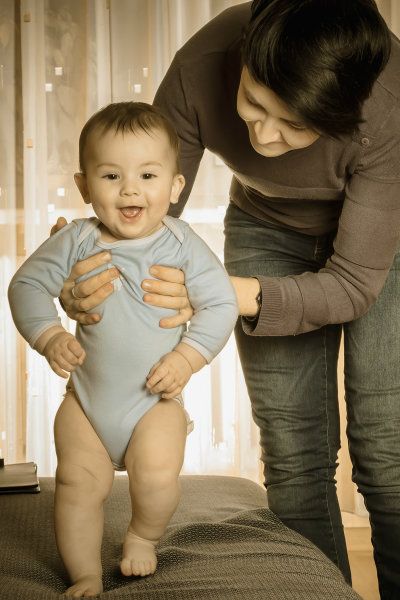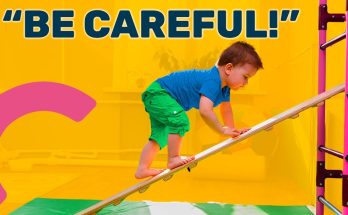Teaching your baby to walk is one of the most exciting milestones in both their development and yours as a parent. Between 9 and 12 months, your baby is likely to be going through rapid physical and cognitive growth. While each baby develops at their own pace, this period often marks the beginning of their first steps. Below are seven steps to help guide your baby toward walking during this critical phase of their development.
1. Give Your Baby Time on the Floor
One of the most important aspects of helping your baby walk is giving them ample time to develop the strength and coordination they need. While it can be tempting to keep your baby in a walker or chair, it’s crucial that they spend plenty of time on their tummy or crawling on the floor. Crawling helps build the muscles in the arms, legs, and core, all of which are essential for walking. Tummy time strengthens their neck and upper body muscles, while crawling helps improve balance and coordination.
Encourage your baby to explore their environment, but be sure to supervise them at all times. A safe, baby-proofed space can allow them to move freely and practice their new skills without the risk of injury.
2. Support Standing and Cruising
Around 9 months, babies may start to pull themselves up to stand using furniture, a skill known as “cruising.” This stage is essential for building strength in their legs and core muscles, as they learn how to support their body weight. To encourage this, position your baby near sturdy furniture or surfaces that are safe for them to hold onto. You can support them gently by holding their waist or hands to give them a little extra balance.
Try to make standing and cruising a fun activity. Place toys or objects they love just out of reach, so they have the incentive to pull up and move towards them. It may also help to show your baby how to cruise by guiding their hands along the surface. Over time, they will develop the confidence to cruise independently.
3. Use Push Toys to Encourage Walking
Push toys are excellent tools for helping your baby transition from cruising to walking. These toys allow your baby to practice standing while offering support as they take their first steps. Many push toys have handles for your baby to hold onto, along with wheels that roll easily. They often feature colorful designs and sounds to keep your baby entertained.
When using a push toy, ensure it is age-appropriate and sturdy. Start by positioning the toy in front of your baby and showing them how to push it. As your baby gains confidence and balance, they will start to walk by themselves, using the toy for support. Be sure to choose a flat, smooth surface for walking practice.
4. Encourage Walking with Assistance
Once your baby begins to pull themselves up and cruise along furniture, they may be ready to take their first few steps with your assistance. Hold your baby under the arms or by the hands, offering just enough support for them to feel stable. Gently encourage them to lift one foot and take a step forward, while you guide them along.
While it’s important not to rush this stage, your baby may feel more confident if they see you walking and encouraging them with praise. Offer a steady hand and make the experience lighthearted and fun. Your baby will likely become more comfortable taking steps when they feel safe and secure in your presence.
5. Promote Barefoot Walking
Barefoot walking is ideal for babies learning to walk because it helps strengthen the muscles and tendons in their feet. When your baby starts taking steps, try to allow them to walk barefoot on soft, safe surfaces such as carpet, grass, or rugs. Walking barefoot helps improve their balance, coordination, and sensory perception, all of which are important for walking with stability.
Shoes are not necessary until your baby is walking independently outdoors or in public spaces. When you do buy shoes for your baby, choose soft, flexible shoes that mimic the feeling of walking barefoot, as they will help their feet develop properly.
6. Create a Safe Environment for Walking Practice
Creating a safe environment for your baby to practice walking is essential. This means eliminating any obstacles that could cause injury and ensuring that sharp corners, dangerous items, or small objects are out of reach. Baby-proof your home by padding furniture corners, securing electrical outlets, and keeping cleaning products or chemicals locked away.
Set up an area with soft surfaces for your baby to practice their walking. Carpets or foam mats are ideal since they offer a cushioned landing if your baby loses their balance and falls. As your baby becomes more confident, you can introduce them to harder surfaces, but always supervise them closely.
7. Provide Positive Reinforcement and Patience
Learning to walk is a big challenge for your baby, and they may fall or become frustrated as they practice. Be sure to offer lots of praise and encouragement when they take steps or make progress, even if it’s just a small amount. Your positive reinforcement will help your baby feel proud of their achievements and motivated to keep trying.
Patience is key. Every baby progresses at their own pace, so try not to compare your baby’s progress to others. Some babies may start walking as early as 9 months, while others may not walk independently until closer to 18 months. It’s important to celebrate each small success and remember that your baby is learning important skills at every stage, even if they aren’t walking just yet.
Additional Tips to Help Your Baby Walk:
- Lead with Play: Turn walking practice into a fun game. You can use toys, favorite objects, or even your own hands to encourage your baby to take steps toward them. Babies are motivated by fun activities, so use playtime to encourage movement.
- Stay Consistent: Babies need consistent opportunities to practice walking. While you don’t need to schedule formal “walking lessons,” offering ample time each day for your baby to explore and practice walking will be beneficial.
- Don’t Force It: Some babies may be hesitant to walk, and that’s okay. If your baby seems frustrated or uninterested in walking, it’s essential to give them time to build their confidence. Forcing them before they’re ready can create unnecessary stress for both of you.
- Offer Praise: When your baby does take a step, cheer them on with enthusiasm! Positive reinforcement helps your baby feel proud of their achievements and motivates them to keep moving forward.
- Be Patient with Falls: Falling is a natural part of the walking process. When your baby falls, offer gentle reassurance and encourage them to try again. Babies learn through trial and error, and falls help them develop better balance and coordination.
Conclusion
The journey of teaching your baby to walk is a joyous and rewarding experience. From crawling and cruising to finally taking those first steps, each stage is a stepping stone toward greater independence. By following these seven steps—providing ample floor time, supporting standing and cruising, using push toys, promoting barefoot walking, ensuring a safe environment, and offering patience and encouragement—you are helping your baby build the confidence and skills they need to master walking.
Remember that every baby is unique, so don’t rush the process. With your love, support, and patience, your little one will soon be taking steps on their own, and you’ll be there to celebrate their first solo walk.



